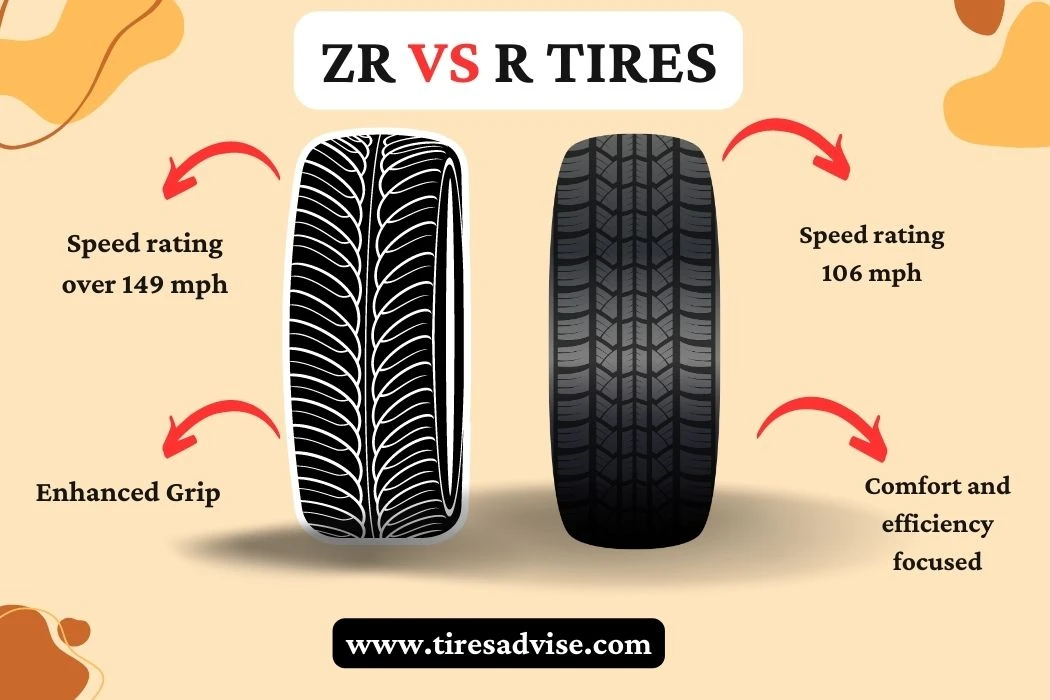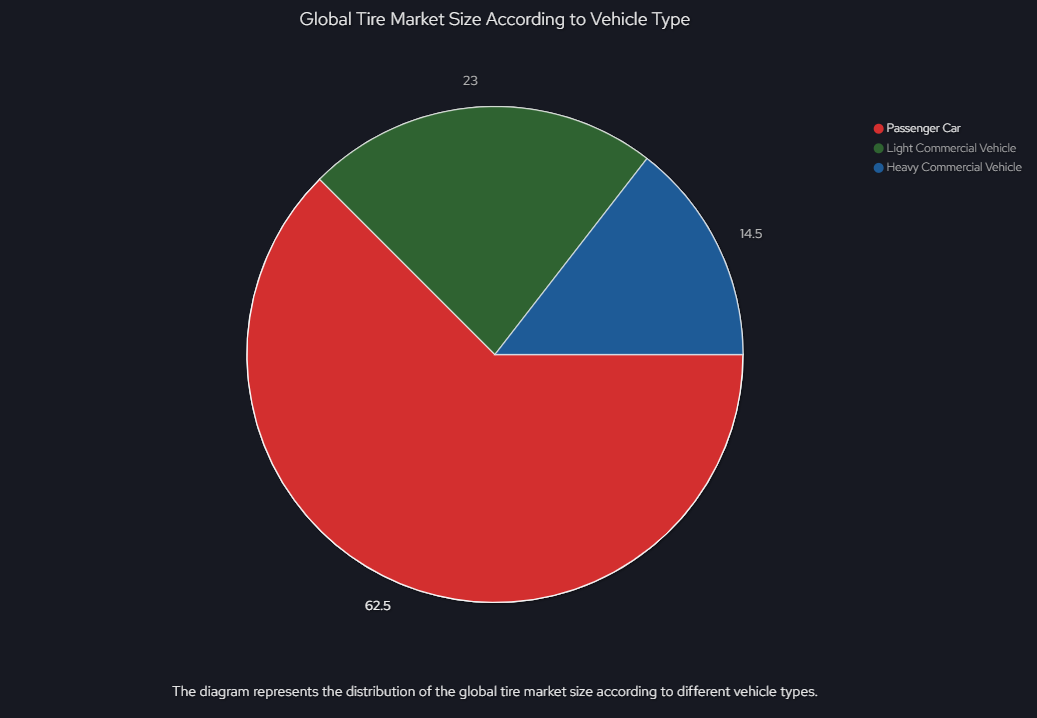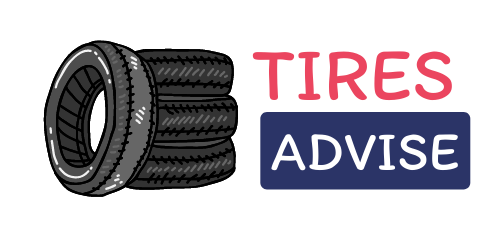So, you’ve noticed those ZR and R letters on your tires and wondered what the fuss is all about? You’re in good company!
Imagine ZR as the flashy sports car of tires, and R as the trusty family sedan. But wait, there’s more under the hood.
Radial tires dominate the global market with a share of over 90% in the passenger car segment as of 2020, according to Maximize Market Research, understanding these letters is like having a roadmap to your car’s performance.
Ready to take a deeper dive? Pull up a chair, pour yourself a cup of joe, and let’s explore the winding roads of ZR vs. R tires.
ZR Tires vs. R Tires: What’s the Difference?

1. The Meaning Behind the Letters
What’s in a ZR?
- Z: This is all about speed. ZR tires are like the racehorses of the tire world, designed for speeds over 149 mph (240 km/h).
- R: Radial construction. It’s a design that makes the tire flexible and stable.
And what about just R?
- R: This can mean two things. Radial construction, like in ZR, or a speed rating of 106 mph (170 km/h).
Confused? Don’t worry; we’ll break it down further.
2. Speed Rating: The Need for Speed
Ever wonder why some cars can go faster than others? Part of it is the tires.
ZR Tires:
- Historically, ZR was a symbol for high-speed tires.
- Nowadays, it’s more of a marketing tool, and the actual speed is defined by another symbol like Y, which means up to 300 km/h (186 mph).
R Tires:
- If R is about speed, it’s 106 mph (170 km/h).
- But remember, R also stands for radial construction, so context matters!
So, what’s the big deal about speed ratings? Well, it’s about safety and performance. You wouldn’t wear flip-flops to run a marathon, right? Same with tires; you need the right ones for your driving style.
3. Construction: It’s What’s Inside that Counts
Ever cut open a tire? Me neither, but here’s what’s inside:
ZR Tires:
- Same radial construction as R tires.
- Designed for high performance, like sports cars.
R Tires:
- Radial construction, the most common type.
- Suitable for most passenger cars, SUVs, and light trucks.
Think of radial construction like the foundation of a house. It’s what gives the tire its shape and stability.
4. Usage: Finding the Right Fit
ZR Tires:
- Best for high-performance vehicles.
- Not just about speed; they offer better grip and can withstand higher temperatures.
R Tires:
- Great for everyday driving.
- More about comfort and efficiency.
Choosing the right tire is like finding the perfect pair of shoes. You wouldn’t wear high heels to hike a mountain, right? Same with tires; you need the right ones for your car and driving habits.
5. Modern Changes: Out with the Old, In with the New
Times change, and so do tires:
ZR Tires:
- The ZR symbol has lost some of its significance.
- Now, it’s often combined with other symbols to define speed.
R Tires:
- Still represents radial construction.
- Can also represent a specific speed rating.
It’s like how we used to dial a phone, and now we just tap a screen. Things evolve, and so do tires.
6. ZR Tires vs. R Tires – Summary
| Aspect | ZR Tires | R Tires |
|---|---|---|
| Meaning of Letters | Z: Speed rating over 149 mph R: Radial construction | R: Radial construction or Speed rating 106 mph |
| Speed Rating | Historically for high speeds, now often combined with other symbols | Can represent 106 mph, context matters |
| Construction | Radial, designed for high performance | Radial, common in most vehicles |
| Usage | Best for sports cars and high-performance vehicles | Suitable for everyday driving, passenger cars |
| Grip & Temperature | Enhanced grip, withstands higher temperatures | Comfort and efficiency focused |
| Modern Changes | ZR symbol less significant, combined with other speed symbols | Represents radial construction or specific speed rating |
Analyzing the Sustainability of ZR vs R Tires – Environmental Impact

Materials and Composition
- ZR Tires: Think of these as the high-tech gadgets of the tire world. They’re made of synthetic rubber, silica, and carbon black. Great for performance, but a bit like fast food for the planet – not the healthiest choice.
- R Tires: These are more like your grandma’s home-cooked meals – simpler and often more wholesome. They’re constructed with natural rubber and fewer synthetic compounds, making them a friendlier option for Mother Earth.
Tip: Choosing tires? It’s a bit like picking out groceries. ZR tires might be the flashy, tasty option, but R tires could be the organic, eco-friendly choice that sits better with your conscience.
Manufacturing Processes
Ever wonder how tires are made? It’s a bit like baking, but with more smoke and less frosting:
- ZR Tires: These need a lot of energy to make, kind of like baking a fancy soufflé. The complex structure needed for high-speed performance means more energy and, unfortunately, more CO2 emissions.
- R Tires: More like baking bread – simpler processes, less energy, and fewer emissions.
Study Insight: Picture this: According to research in the International Journal of Environmental Research, R tires are like riding a bike instead of driving – they produce about 20% less CO2 during manufacturing compared to ZR tires.
Recycling and End-of-Life Management
Ever tried to recycle an old phone? It’s a bit like that with tires:
- ZR Tires: Tricky to recycle, like trying to take apart a smartphone. Specialized recycling facilities might be needed.
- R Tires: More like recycling a paper bag – generally easier and can often be turned into something new.
Note: Recycling tires is like sorting your recycling bin – it’s essential, and local centers can guide you on the best methods for different tire types.
Expert Advice: If you’re the kind of person who brings reusable bags to the grocery store, you might lean towards R tires. But remember, it’s like choosing between hiking boots and running shoes – consult with a tire specialist to find the best fit for your needs and driving conditions. Finding that sweet spot between performance and caring for our planet can make your drive feel just right. 🌍💚
Price Differences in ZR vs R Tires – Cost Analysis
Alright, let’s dive into the nitty-gritty of the price differences between ZR and R tires. We’ll break it down like you’re shopping for a new pair of shoes, but for your car. Ready? Here we go!
Performance and Durability
- ZR Tires: These are like the designer heels of the tire world. They’re built for speed and performance, and they come with a price tag to match. Think of them as the luxury option, with prices ranging widely depending on the brand and specifications.
- R Tires: More like your everyday sneakers. They’re reliable, comfortable, and won’t break the bank. You can find R tires ranging from $184.96 to $490.99 per tire, depending on the size and features.
Brand Influence
- ZR Tires: With brands like Nitto and Vee Rubber offering ZR tires, you’re looking at a variety of options, each with its own price point. It’s like choosing between Nike and Adidas – different styles, different costs.
- R Tires: Brands like Radar offer R tires with prices that can fit a more modest budget. It’s the practical choice, like grabbing a pair of sturdy work boots.
Market Trends
- ZR Tires: These tires are like the latest fashion trend. They’re popular in the high-performance market, and that demand can drive up the price.
- R Tires: Think of these as the classic blue jeans of tires. They’re always in style, always reliable, and generally more affordable.
Expert Shopping Tips
- Shop Around: Just like hunting for a bargain on a new jacket, don’t be afraid to compare prices and look for deals. Online retailers like SimpleTire offer a range of options for both ZR and R tires.
- Consider Your Needs: Are you looking for the flashy sports car experience or the dependable family ride? Your choice between ZR and R tires should reflect your driving style and budget.
- Ask the Pros: Don’t hesitate to consult with a tire specialist. It’s like asking a tailor for advice on a suit – they know the fit and can guide you to the right choice.
Note: Remember, the right tire isn’t just about the price tag. It’s about finding the perfect fit for your ride, whether you’re cruising down the highway or navigating city streets. So, next time you’re in the market for tires, think about what you really need, and don’t be afraid to ask for advice. After all, it’s not just about getting from A to B; it’s about enjoying the ride.
Conclusion: Rolling Forward
So, ZR or R? It’s not just about letters; it’s about understanding what you need from a tire. Whether you’re cruising down the highway or zipping around a racetrack, the right tire makes all the difference.
Remember, it’s not just about speed or construction; it’s about finding the perfect fit for your vehicle and driving style. So next time you’re shopping for tires, you’ll know exactly what to look for.
Still have questions? That’s what I’m here for! Feel free to ask, and let’s keep this conversation rolling. After all, knowledge is power, especially when it comes to tires. Happy driving!
Frequently Asked Questions (FAQs)
Can I mix ZR and R tires on my car?
It’s generally not recommended to mix ZR and R tires on the same vehicle, as they have different speed ratings and performance characteristics. Mixing them could lead to uneven wear and potentially affect handling and safety.
Can I use ZR tires instead of R?
Yes, you can use ZR tires instead of R tires, provided that the ZR tires meet the speed rating and load capacity requirements of your vehicle. Always consult your vehicle’s manual or a tire specialist to ensure compatibility.
How long do ZR tires typically last compared to R tires?
ZR tires, designed for high performance, may wear out faster than R tires, especially if driven aggressively. On average, ZR tires may last around 30,000 to 40,000 miles, while R tires can last up to 60,000 miles, depending on driving conditions and maintenance.
Are ZR tires more fuel-efficient than R tires?
ZR tires are generally not designed with fuel efficiency as a primary focus; instead, they prioritize performance and speed. R tires may offer better fuel efficiency due to their construction and materials. The difference in fuel efficiency can vary based on the specific brand and model.

